
USS Acubens (AKS-5) was an Acubens-class general stores issue ship commissioned by the U.S. Navy for service in World War II, named after the star Acubens, the alpha star in Cancer. She was responsible for delivering and disbursing goods and equipment to locations in the war zone.

USS Kochab (AKS-6) was an Acubens-class general stores issue ship commissioned by the U.S. Navy for service in World War II. She was responsible for delivering and disbursing goods and equipment to locations in the war zone. The vessel was constructed by Delta Shipbuilding Co. of New Orleans, Louisiana and launched on 8 March 1944 under a Maritime Commission contract. After being acquired the U.S. Navy, the vessel was converted into a general stores ship and entered service on 4 November 1944. Kochab supported American operations in the Pacific Theater, sailing between US bases on Pacific islands. Following the war's end, Kochab sailed to the US with returning personnel and operated along the United States West Coast before being decommissioned on 17 April 1946. The vessel was then placed in reserve. Kochab was sold for scrap in 1965.
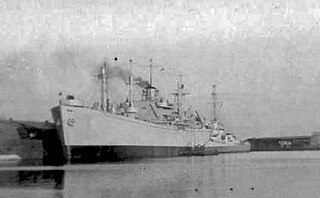
USS Luna (AKS-7) was a Liberty ship built in the United States during World War II. She was originally named for Harriet Hosmer, a neoclassical sculptor, considered the first female professional sculptor. She was converted shortly after completion to an Acubens-class general stores issue ship and renamed Luna, the latin name for the Moon. She was responsible for delivering and disbursing goods and equipment to locations in the war zone.
USS Volans (AKS-9) was an Acubens-class general stores issue ship commissioned by the U.S. Navy for service in World War II. She was responsible for delivering and disbursing goods and equipment to locations in the war zone.

USS Cybele (AKS-10) was an Acubens-class general stores issue ship commissioned by the U.S. Navy for service in World War II. She was responsible for delivering and disbursing goods and equipment to locations in the Pacific war zone. The vessel was launched on 9 October 1944 by Delta Shipbuilding Co., New Orleans, Louisiana and entered service with the U.S. Navy on 16 April 1945. The vessel was decommissioned on 22 August 1946 and transferred to the Maritime Commission for disposal on 24 April 1947. The vessel was scrapped in 1965.

USS Gratia (AKS-11) was an Acubens-class general stores issue ship commissioned by the U.S. Navy for service in World War II. She was responsible for delivering and disbursing goods and equipment to locations in the war zone.

USS Hecuba (AKS-12) was an Acubens-class general stores issue ship commissioned by the U.S. Navy for service in World War II. She was responsible for delivering and disbursing goods and equipment to locations in the war zone.

USS Hesperia (AKS-13) was an Acubens-class general stores issue ship commissioned by the U.S. Navy for service in World War II. She was responsible for delivering and disbursing goods and equipment to locations in the war zone.
USS Viburnum (AN-57/YN-76) was a Ailanthus-class net laying ship which served with the U.S. Navy in the Pacific Ocean theatre of operations. While operating in the Caroline Islands, she was severely damaged when struck by what appeared to be a Japanese torpedo. However, she continued her work as well as she could, and, when she returned to the United States, she was considered too damaged to repair. She was sold in her damaged condition, and was eventually scrapped.

USS Malanao (AG-44) was a commercial cargo ship acquired by the U.S. Navy during World War II. She was used to transport cargo in the South Pacific Ocean, and was decommissioned after the end of the war.

USS Belle Isle (AG-73/AKS-21) was a Basilan-class miscellaneous auxiliary acquired by the U.S. Navy during World War II. Belle Isle was configured as a repair ship and used in Pacific Ocean operations. At war’s end she was converted to a stores ship before being finally decommissioned.
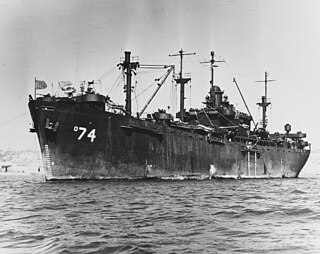
USS Coasters Harbor (AG-74) was a Basilan-class miscellaneous auxiliary acquired by the U.S. Navy during World War II. She was configured as a repair ship and sent to the Pacific Ocean just as the war ended. She was retained to participate in atomic testing at Bikini Atoll.
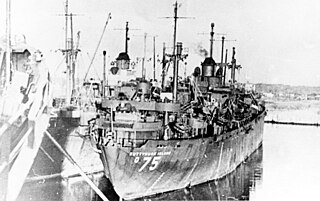
USS Cuttyhunk Island (AG-75/AKS-23) was a Belle Isle-class miscellaneous auxiliary acquired by the U.S. Navy during World War II. Cuttyhunk Island was built as the war was coming to an end, and was used as a transport. She was later classified as a stores ship and eventually scrapped.
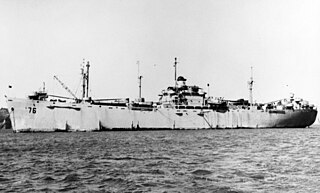
USS Avery Island (AG-76/AKS-24) was a Basilan-class miscellaneous auxiliary acquired by the U.S. Navy during World War II. She was used to transport personnel and carry cargo and was inactivated and disposed of shortly after the war.

USS Indian Island (AG-77/AKS-25) was a Basilan-class miscellaneous auxiliary acquired by the U.S. Navy shortly before the end of World War II. She was used to transport personnel and carry cargo and was inactivated and disposed of shortly after the war.
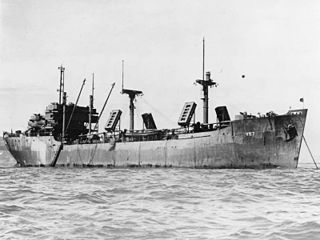
USS Pontotoc (AK-206/AG-94/AVS-7) was an Alamosa-class cargo ship acquired by the US Navy shortly before the end of World War II. She was converted into a Gwinnett-class aviation stores issue ship to carry aviation parts and spares, and to issue them to the US Pacific Fleet and activities as needed.
USS Proton (AG-147/AKS-28) -- also known as USS LST-1078 – was an LST-542-class tank landing ship launched by the U.S. Navy during the final months of World War II. Proton served as a troop ship, a cargo ship and as an electronic parts supply ship for the U.S. Pacific Fleet and was decommissioned following the Korean War.

USS League Island (AG-149/AKS-30) – also known as USS LST-1097 - was an LST-511-class tank landing ship launched by the U.S. Navy during the final months of World War II. League Island served as a supply and stores-issue ship for the U.S. 7th Fleet, and was decommissioned after the war.

USS Faribault (AK-179) was an Alamosa-class cargo ship acquired by the U.S. Navy during the final months of World War II. Faribault served US military forces in the Pacific Ocean until shortly after the war when she was deactivated. During the Korean War, she was reactivated and served with distinction, having been awarded two battle stars before final decommissioning.

USS Grainger (AK-184) was an Alamosa-class cargo ship that served the US Navy during the final months of World War II. In 1947 she was placed back in service and served in the Korean War, earning two battle stars
















